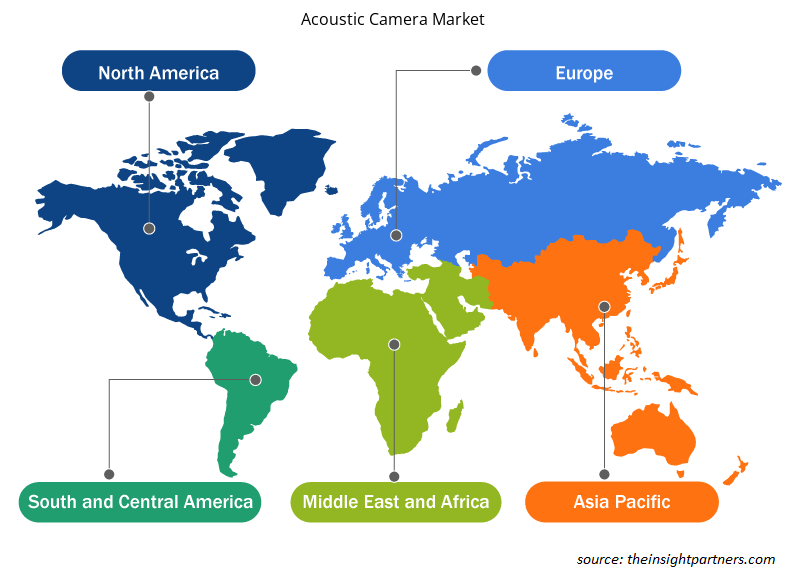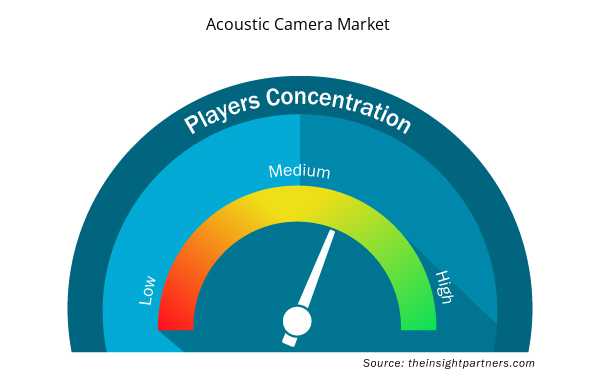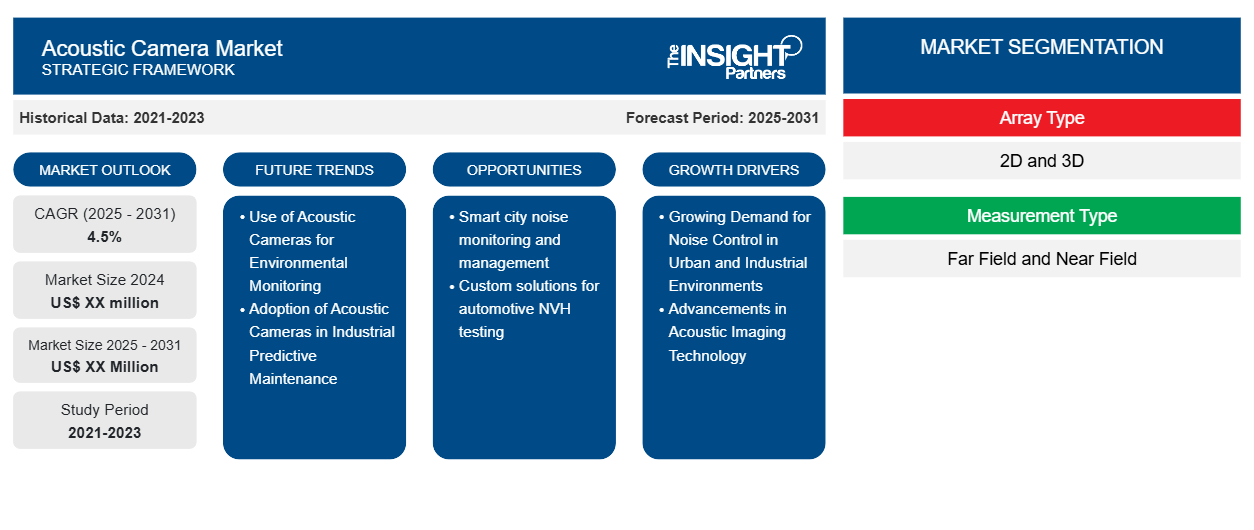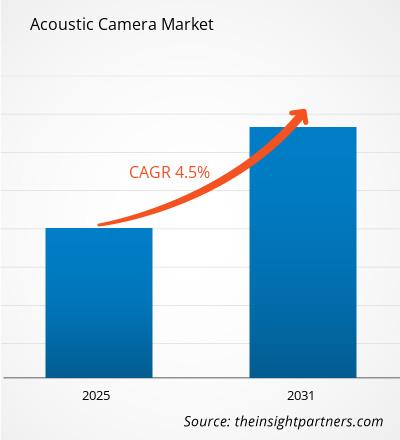Es wird erwartet, dass der Markt für akustische Kameras von 2023 bis 2031 eine durchschnittliche jährliche Wachstumsrate (CAGR) von 4,5 % verzeichnet, wobei die Marktgröße von XX Millionen US-Dollar im Jahr 2023 auf XX Millionen US-Dollar bis 2031 wächst.
Der Bericht ist segmentiert nach Array-Typ (2D und 3D), Messtyp (Fernfeld und Nahfeld), Anwendung (Lärmquellenidentifikation, Leckageerkennung und andere), Endbenutzer (Automobil, Luft- und Raumfahrt, Elektronik, Bildung und Forschung, Infrastruktur, Energie und Strom und andere). Die globale Analyse ist weiter auf regionaler Ebene und nach wichtigen Ländern aufgeschlüsselt. Der Bericht bietet den Wert in USD für die oben genannte Analyse und Segmente
Zweck des Berichts
Der Bericht „Akustische Kameras – Markt“ von The Insight Partners soll die aktuelle Situation und das zukünftige Wachstum sowie die wichtigsten treibenden Faktoren, Herausforderungen und Chancen beschreiben. Dies wird verschiedenen Geschäftspartnern Einblicke geben, wie zum Beispiel:
- Technologieanbieter/-hersteller: Um die sich entwickelnde Marktdynamik zu verstehen und die potenziellen Wachstumschancen zu kennen, damit sie fundierte strategische Entscheidungen treffen können.
- Investoren: Durchführung einer umfassenden Trendanalyse hinsichtlich der Marktwachstumsrate, der finanziellen Marktprognosen und der Chancen entlang der Wertschöpfungskette.
- Regulierungsbehörden: Sie regulieren Richtlinien und polizeiliche Maßnahmen auf dem Markt mit dem Ziel, Missbrauch zu minimieren, das Vertrauen der Anleger zu bewahren und die Integrität und Stabilität des Marktes aufrechtzuerhalten.
Akustische Kamera Marktsegmentierung
Array-Typ
- 2D und 3D
Messtyp
- Fernfeld und Nahfeld
Anwendung
- Identifizierung von Lärmquellen
- Leckageortung
- Sonstiges
Endbenutzer
- Automobilindustrie
- Luft- und Raumfahrt
- Elektronik
- Bildung und Forschung
- Infrastruktur
- Energie und Leistung
- Sonstiges
Endbenutzer
- Automobilindustrie
- Luft- und Raumfahrt
- Elektronik
- Bildung und Forschung
- Infrastruktur
- Energie und Leistung
- Sonstiges
Passen Sie diesen Bericht Ihren Anforderungen an
Sie erhalten kostenlos individuelle Anpassungen an jedem Bericht, einschließlich Teilen dieses Berichts oder einer Analyse auf Länderebene, eines Excel-Datenpakets sowie tolle Angebote und Rabatte für Start-ups und Universitäten.
- Holen Sie sich die wichtigsten Markttrends aus diesem Bericht.Dieses KOSTENLOSE Beispiel umfasst eine Datenanalyse von Markttrends bis hin zu Schätzungen und Prognosen.
Wachstumstreiber auf dem Markt für akustische Kameras
- Wachsende Nachfrage nach Lärmschutz in städtischen und industriellen Umgebungen: Mit zunehmender Urbanisierung und Expansion der Industrie wird der Bedarf an Lärmschutz und -überwachung immer wichtiger. Akustische Kameras, die eine Echtzeitvisualisierung von Schallquellen ermöglichen, werden zunehmend auf Baustellen, in Fertigungsanlagen und in städtischen Gebieten eingesetzt, um Lärmbelästigung zu identifizieren und zu mildern. Diese wachsende Nachfrage nach Lärmmanagement treibt den Markt für akustische Kameras an.
- Fortschritte in der akustischen Bildgebungstechnologie: Technologische Fortschritte in der akustischen Bildgebung, wie z. B. verbesserte Auflösung, bessere Schalllokalisierung und Integration mit digitalen Verarbeitungstools, sind wichtige Treiber für den Markt für akustische Kameras. Diese Innovationen machen akustische Kameras präziser, benutzerfreundlicher und vielseitiger, sodass sie in einer Vielzahl von Branchen eingesetzt werden können, von der Automobil- bis zur Luft- und Raumfahrtindustrie, was zu ihrer zunehmenden Akzeptanz beiträgt.
Zukünftige Trends auf dem Markt für akustische Kameras
- Einsatz von akustischen Kameras zur Umweltüberwachung: Akustische Kameras werden zunehmend zur Umweltüberwachung eingesetzt, um Lärmbelästigung und ihre Auswirkungen auf Ökosysteme zu verfolgen. Sie werden auch zur Erforschung der Tierwelt, zur Überwachung industrieller Emissionen und zur Kontrolle des Lärmpegels in Städten eingesetzt. Dieser Trend spiegelt die wachsende Bedeutung von Nachhaltigkeit und Umweltverantwortung in allen Branchen wider, wodurch akustische Kameras zu einem unverzichtbaren Instrument zur Bewältigung dieser Probleme werden.
- Einsatz von Akustikkameras in der industriellen vorausschauenden Wartung: Die vorausschauende Wartung ist ein neuer Trend in der Industrie, bei dem Akustikkameras eingesetzt werden, um durch die Überwachung ungewöhnlicher Geräusche frühe Anzeichen von Geräteausfällen zu erkennen. Die Fähigkeit, Anomalien wie Luftlecks, mechanische Fehlfunktionen oder Vibrationen zu erkennen, bevor sie zu kostspieligen Reparaturen führen, treibt den Einsatz von Akustikkameras in der Fertigungs-, Energie- und Transportbranche für effiziente Wartungsabläufe voran.
Marktchancen für akustische Kameras
- Intelligente Lärmüberwachung und -bekämpfung in Städten: Die Lärmbelästigung in Städten wird mithilfe akustischer Kameranetzwerke überwacht und kontrolliert. Diese Kameranetzwerke liefern unmittelbare Daten über den Lärm, der durch Verkehr, Bautätigkeiten und Unterhaltungsangebote verursacht wird. Daher kann die zuständige Behörde auf der Grundlage dieser Informationen Vorschriften erlassen oder Maßnahmen zur Lärmbekämpfung an Punktquellen ergreifen.
- Kundenspezifische Lösungen für NVH-Tests im Automobilbereich: Kundenspezifische Lösungen für NVH-Tests in Automobilanwendungen. Für die Durchführung von NVH-Tests benötigt der Automobilhersteller moderne Akustikkameras. Kundenspezifische Lösungen helfen dabei, die Geräuschquelle im Fahrzeug zu ermitteln, optimale Schalldämmung zu gewährleisten und den Komfort der Passagiere zu erhöhen.
Regionale Einblicke in den Markt für akustische Kameras
Die regionalen Trends und Faktoren, die den Markt für akustische Kameras im gesamten Prognosezeitraum beeinflussen, wurden von den Analysten von Insight Partners ausführlich erläutert. In diesem Abschnitt werden auch die Marktsegmente und die Geografie von akustischen Kameras in Nordamerika, Europa, im asiatisch-pazifischen Raum, im Nahen Osten und Afrika sowie in Süd- und Mittelamerika erörtert.

- Holen Sie sich die regionsspezifischen Daten für den Markt für akustische Kameras
Umfang des Marktberichts für akustische Kameras
| Berichtsattribut | Details |
|---|---|
| Marktgröße im Jahr 2023 | XX Millionen US-Dollar |
| Marktgröße bis 2031 | XX Millionen US-Dollar |
| Globale CAGR (2023 - 2031) | 4,5 % |
| Historische Daten | 2021-2022 |
| Prognosezeitraum | 2024–2031 |
| Abgedeckte Segmente | Nach Array-Typ
|
| Abgedeckte Regionen und Länder | Nordamerika
|
| Marktführer und wichtige Unternehmensprofile |
|
Marktteilnehmerdichte für akustische Kameras: Auswirkungen auf die Geschäftsdynamik verstehen
Der Markt für akustische Kameras wächst rasant, angetrieben durch die steigende Nachfrage der Endnutzer aufgrund von Faktoren wie sich entwickelnden Verbraucherpräferenzen, technologischen Fortschritten und einem größeren Bewusstsein für die Vorteile des Produkts. Mit steigender Nachfrage erweitern Unternehmen ihr Angebot, entwickeln Innovationen, um die Bedürfnisse der Verbraucher zu erfüllen, und nutzen neue Trends, was das Marktwachstum weiter ankurbelt.
Die Marktteilnehmerdichte bezieht sich auf die Verteilung der Firmen oder Unternehmen, die in einem bestimmten Markt oder einer bestimmten Branche tätig sind. Sie gibt an, wie viele Wettbewerber (Marktteilnehmer) in einem bestimmten Marktraum im Verhältnis zu seiner Größe oder seinem gesamten Marktwert präsent sind.
Die wichtigsten auf dem Markt für akustische Kameras tätigen Unternehmen sind:
- Bruel und Kjaer
- CAE Software and Systems GmbH
- gfai tech GmbH
- Microflown-Technologien
- Norsonic AS
Haftungsausschluss : Die oben aufgeführten Unternehmen sind nicht in einer bestimmten Reihenfolge aufgeführt.

- Überblick über die wichtigsten Akteure auf dem Markt für akustische Kameras
Wichtige Verkaufsargumente
- Umfassende Abdeckung: Der Bericht deckt die Analyse von Produkten, Diensten, Typen und Endbenutzern des Marktes für akustische Kameras umfassend ab und bietet einen ganzheitlichen Überblick.
- Expertenanalyse: Der Bericht basiert auf dem umfassenden Verständnis von Branchenexperten und Analysten.
- Aktuelle Informationen: Der Bericht stellt durch die Abdeckung aktueller Informationen und Datentrends Geschäftsrelevanz sicher.
- Anpassungsoptionen: Dieser Bericht kann angepasst werden, um spezifische Kundenanforderungen zu erfüllen und die Geschäftsstrategien optimal anzupassen.
Der Forschungsbericht zum Markt für akustische Kameras kann daher dabei helfen, die Branchensituation und Wachstumsaussichten zu entschlüsseln und zu verstehen. Obwohl es einige berechtigte Bedenken geben kann, überwiegen die allgemeinen Vorteile dieses Berichts tendenziell die Nachteile.
- Historische Analyse (2 Jahre), Basisjahr, Prognose (7 Jahre) mit CAGR
- PEST- und SWOT-Analyse
- Marktgröße Wert/Volumen – Global, Regional, Land
- Branche und Wettbewerbsumfeld
- Excel-Datensatz



Report Coverage
Revenue forecast, Company Analysis, Industry landscape, Growth factors, and Trends

Segment Covered
This text is related
to segments covered.

Regional Scope
North America, Europe, Asia Pacific, Middle East & Africa, South & Central America

Country Scope
This text is related
to country scope.
Häufig gestellte Fragen
Some of the customization options available based on the request are an additional 3-5 company profiles and country-specific analysis of 3-5 countries of your choice. Customizations are to be requested/discussed before making final order confirmation# as our team would review the same and check the feasibility
The report can be delivered in PDF/PPT format; we can also share excel dataset based on the request
Integration of AI and machine learning for enhanced sound visualization, Enhanced workplace safety standards
Integration of 3D visualization capabilities
The Acoustic Camera Market is estimated to witness a CAGR of 4.5% from 2023 to 2031
Trends and growth analysis reports related to Electronics and Semiconductor : READ MORE..
1. Bruel and Kjaer2. CAE Software and Systems GmbH3. gfai tech GmbH4. Microflown Technologies5. Norsonic AS6. Siemens Product Lifecycle Management Software Inc. 7. SINUS Messtechnik GmbH8. SM Instruments9. Sorama10. Wibro-Akustyka
The Insight Partners performs research in 4 major stages: Data Collection & Secondary Research, Primary Research, Data Analysis and Data Triangulation & Final Review.
- Data Collection and Secondary Research:
As a market research and consulting firm operating from a decade, we have published and advised several client across the globe. First step for any study will start with an assessment of currently available data and insights from existing reports. Further, historical and current market information is collected from Investor Presentations, Annual Reports, SEC Filings, etc., and other information related to company’s performance and market positioning are gathered from Paid Databases (Factiva, Hoovers, and Reuters) and various other publications available in public domain.
Several associations trade associates, technical forums, institutes, societies and organization are accessed to gain technical as well as market related insights through their publications such as research papers, blogs and press releases related to the studies are referred to get cues about the market. Further, white papers, journals, magazines, and other news articles published in last 3 years are scrutinized and analyzed to understand the current market trends.
- Primary Research:
The primarily interview analysis comprise of data obtained from industry participants interview and answers to survey questions gathered by in-house primary team.
For primary research, interviews are conducted with industry experts/CEOs/Marketing Managers/VPs/Subject Matter Experts from both demand and supply side to get a 360-degree view of the market. The primary team conducts several interviews based on the complexity of the markets to understand the various market trends and dynamics which makes research more credible and precise.
A typical research interview fulfils the following functions:
- Provides first-hand information on the market size, market trends, growth trends, competitive landscape, and outlook
- Validates and strengthens in-house secondary research findings
- Develops the analysis team’s expertise and market understanding
Primary research involves email interactions and telephone interviews for each market, category, segment, and sub-segment across geographies. The participants who typically take part in such a process include, but are not limited to:
- Industry participants: VPs, business development managers, market intelligence managers and national sales managers
- Outside experts: Valuation experts, research analysts and key opinion leaders specializing in the electronics and semiconductor industry.
Below is the breakup of our primary respondents by company, designation, and region:

Once we receive the confirmation from primary research sources or primary respondents, we finalize the base year market estimation and forecast the data as per the macroeconomic and microeconomic factors assessed during data collection.
- Data Analysis:
Once data is validated through both secondary as well as primary respondents, we finalize the market estimations by hypothesis formulation and factor analysis at regional and country level.
- Macro-Economic Factor Analysis:
We analyse macroeconomic indicators such the gross domestic product (GDP), increase in the demand for goods and services across industries, technological advancement, regional economic growth, governmental policies, the influence of COVID-19, PEST analysis, and other aspects. This analysis aids in setting benchmarks for various nations/regions and approximating market splits. Additionally, the general trend of the aforementioned components aid in determining the market's development possibilities.
- Country Level Data:
Various factors that are especially aligned to the country are taken into account to determine the market size for a certain area and country, including the presence of vendors, such as headquarters and offices, the country's GDP, demand patterns, and industry growth. To comprehend the market dynamics for the nation, a number of growth variables, inhibitors, application areas, and current market trends are researched. The aforementioned elements aid in determining the country's overall market's growth potential.
- Company Profile:
The “Table of Contents” is formulated by listing and analyzing more than 25 - 30 companies operating in the market ecosystem across geographies. However, we profile only 10 companies as a standard practice in our syndicate reports. These 10 companies comprise leading, emerging, and regional players. Nonetheless, our analysis is not restricted to the 10 listed companies, we also analyze other companies present in the market to develop a holistic view and understand the prevailing trends. The “Company Profiles” section in the report covers key facts, business description, products & services, financial information, SWOT analysis, and key developments. The financial information presented is extracted from the annual reports and official documents of the publicly listed companies. Upon collecting the information for the sections of respective companies, we verify them via various primary sources and then compile the data in respective company profiles. The company level information helps us in deriving the base number as well as in forecasting the market size.
- Developing Base Number:
Aggregation of sales statistics (2020-2022) and macro-economic factor, and other secondary and primary research insights are utilized to arrive at base number and related market shares for 2022. The data gaps are identified in this step and relevant market data is analyzed, collected from paid primary interviews or databases. On finalizing the base year market size, forecasts are developed on the basis of macro-economic, industry and market growth factors and company level analysis.
- Data Triangulation and Final Review:
The market findings and base year market size calculations are validated from supply as well as demand side. Demand side validations are based on macro-economic factor analysis and benchmarks for respective regions and countries. In case of supply side validations, revenues of major companies are estimated (in case not available) based on industry benchmark, approximate number of employees, product portfolio, and primary interviews revenues are gathered. Further revenue from target product/service segment is assessed to avoid overshooting of market statistics. In case of heavy deviations between supply and demand side values, all thes steps are repeated to achieve synchronization.
We follow an iterative model, wherein we share our research findings with Subject Matter Experts (SME’s) and Key Opinion Leaders (KOLs) until consensus view of the market is not formulated – this model negates any drastic deviation in the opinions of experts. Only validated and universally acceptable research findings are quoted in our reports.
We have important check points that we use to validate our research findings – which we call – data triangulation, where we validate the information, we generate from secondary sources with primary interviews and then we re-validate with our internal data bases and Subject matter experts. This comprehensive model enables us to deliver high quality, reliable data in shortest possible time.


 Holen Sie sich ein kostenloses Muster für diesen Bericht
Holen Sie sich ein kostenloses Muster für diesen Bericht